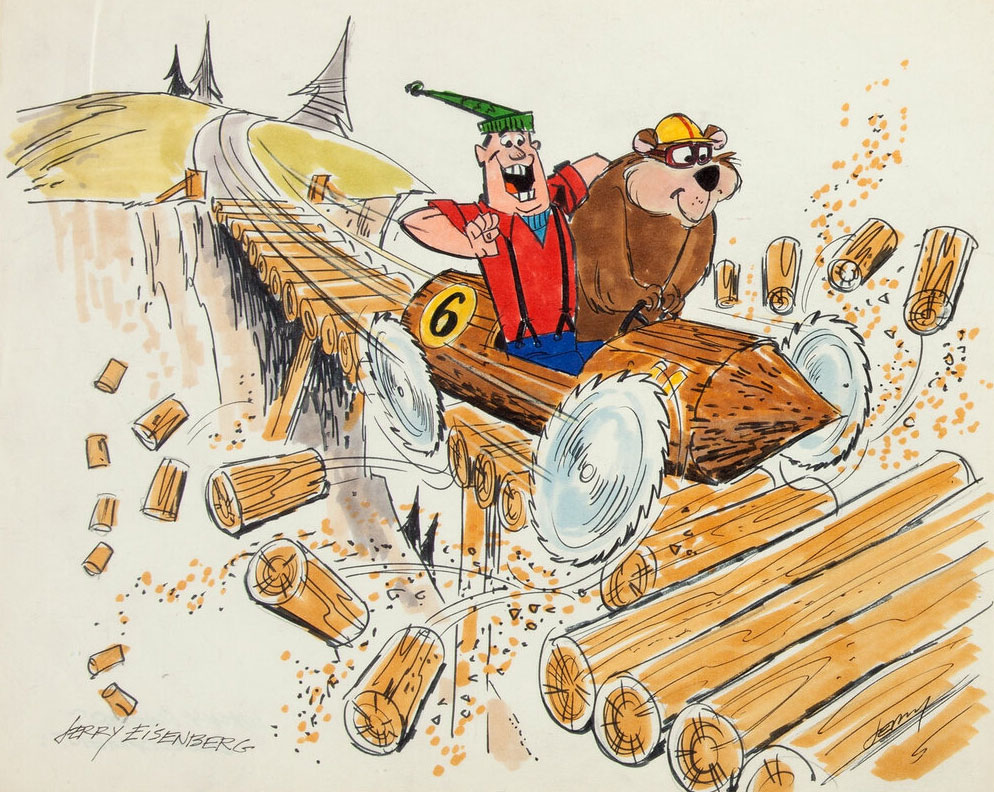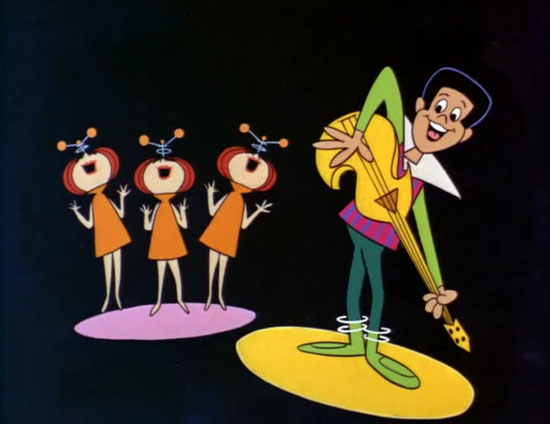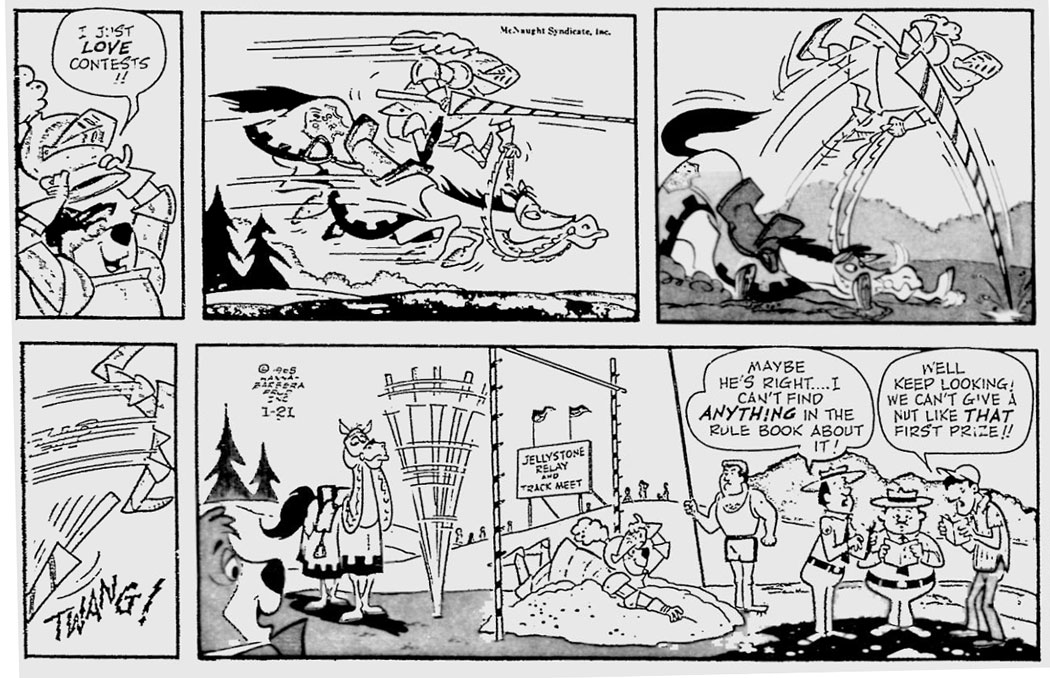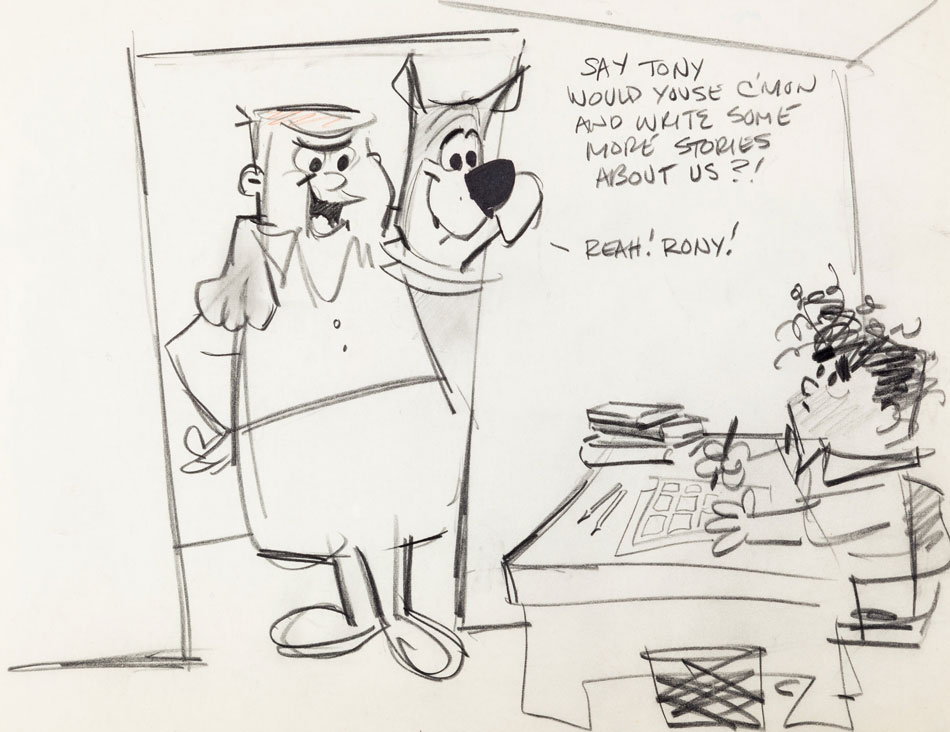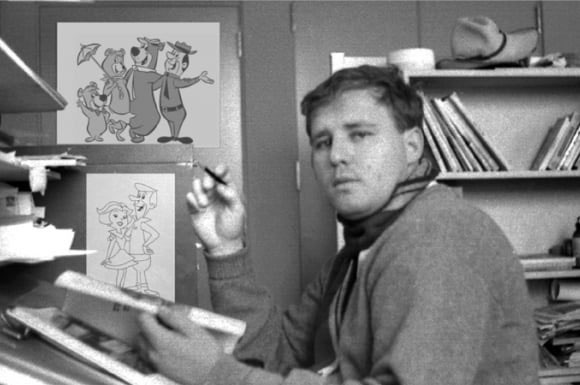'Yogi Bear' Sunday comic of 12 December 1965, drawn by Jerry Eisenberg.
Jerry Eisenberg was an American animator, character designer and lay-out artist. Starting out at MGM (1956-1957) and Warner Bros. (1957-1961), he was best-known for his long career at Hanna-Barbera (1961-1975, 1990s). Between 1961 and 1969, he was also active on Hanna-Barbera's newspaper comic features, contributing to 'The Flintstones' and being the main artist behind the 'Yogi Bear' Sunday comic (1965-1969).
Early life and career
Jerome Theodore Eisenberg was born in 1937 in Los Angeles, California, as the son of animator and funny animal comic book artist Harvey Eisenberg. While still in high school, he already contributed sports cartoons to The Los Angeles Examiner. After winning a sports cartoon contest, Eisenberg received a three-year scholarship to attend the Chouinard Art Institute (since 1961 called the California Institute of the Arts), where he graduated in 1956.
MGM/Warner Brothers
In 1956, through his father's connection with Joseph Barbera, Eisenberg became an assistant-inbetweener at MGM's animation studio, working in the units of Hanna-Barbera (on 'Tom & Jerry') and Mike Lah (on 'Droopy'). However, after only seven months, MGM was unexpectedly forced to close down its animation studio. Four months later (in some interviews Eisenberg claims it was just two months), Eisenberg already found work at another studio, Warner Brothers Cartoons, famous for the 'Looney Tunes' series. Again, he started as an in-betweener, but when Willie Ito left Warners in 1958-1959 to work on Bob Clampett's new show 'Time for Beany' (broadcast in 1962), Eisenberg was asked to become assistant-animator to Ken Harris in Chuck Jones' unit. There he worked mostly on 'Daffy Duck' and 'Wile E. Coyote & the Road Runner' cartoons.
Conceptual art by Jerry Eisenberg for 'Wacky Races' (1968).
Hanna-Barbera: first period
In 1961, Jerry Eisenberg received a call from Joseph Barbera. With the MGM animation department closed down, Barbera and William Hanna had established their own TV animation studio, Hanna-Barbera Productions, which became the most popular and profitable of its kind in the early days of television. He asked Eisenberg to join them as a lay-out and character designer. At the time, many classic Hollywood animation studios were transitioning to TV animation anyway, so Eisenberg didn't have to think long. As his father Harvey Eisenberg had been a lay-out designer too, he advised his son to stay with Warners a little longer, to acquire some more animation skills before joining Hanna-Barbera. He did, but during a holiday period, Eisenberg worked at Hanna-Barbera for a few days, liked the atmosphere there much better and so joined the HB studio as soon as possible afterwards.
For a decade and a half, Eisenberg gave many of their most popular TV shows shape. He co-created 'The Peter Potamus Show' (1964-1966), a nowadays obscure series about an anthropomorphic hippopotamus and a monkey. Eisenberg was inspired by a scene in Roy Crane's newspaper comic 'Wash Tubbs', in which the hero is confronted with a hippopotamus in the jungle. Eisenberg also designed characters for 'Pixie and Dixie', 'Snooper & Blabber', 'Wacky Races', 'Hong Kong Phooey' and 'Super Friends'. Since he enjoyed wacky vehicles, he designed the odd-looking cars in 'Wacky Races' and the aeroplanes in its follow-up 'Dastardly and Muttley in Their Flying Machines' (1969-1970). In this latter show, Eisenberg also created Dastardly's villainous sidekicks, the unintelligible engineer Klunk and always panicky pilot Zilly.
Eisenberg additionally provided lay-outs for shows like 'Huckleberry Hound', 'Quick Draw McGraw', 'The Jetsons', 'Jonny Quest', 'Wait Till Your Father Gets Home', 'Josie and the Pussycats' and 'The Atom Ant/Secret Squirrel Show'. Interviewed on the blog website yowpyowp (March 2011), Eisenberg recalled: "I remember Hanna started an incentive thing. He wanted to get work done quicker, so he said 'Look, if you guys can lay it out in less than five days, you get extra money.' So I used to average four days and get an extra day's pay. Instead of five days, I get six days. And that was nice; the money came in handy." Eisenberg once suggested creating a TV show based on teenagers, but despite creating some artwork for it, Joe Barbera saw nothing in the idea. However, in 1969, a rival cartoon studio had a huge ratings hit with 'The Archies', based on Bob Montana's teen humor comic 'Archie'.
The 'Eep, Opp, Ork, Ah-Ah (Means I Love You)' song.
Of all the Hanna-Barbera shows he worked on, Eisenberg enjoyed 'The Jetsons' the best, since the futuristic designs gave him and his colleagues a chance to be really creative. He also contributed to the show's memorable second episode, which many fans now consider their favorite, 'A Date with Jet Screamer'. Originally broadcast on 30 September 1962, the plot features daughter Judy writing a song for pop star Jet Screamer as part of a contest. Behind her back, father George deliberately changes the lyrics into nonsense, to sabotage her plan. But she unexpectedly wins, while the song 'Eep, Opp, Ork, Ah-Ah (Means I Love You)', becomes a hit. Behind the scenes, the song was written by Hanna-Barbera composer Hoyt Curtin and sung by Howard Morris. Together with Bobe Cannon, Eisenberg provided the lay-out for this musical sequence, which takes up most of the final part of the episode, making it an early precursor of an animated music video. In the mid-1980s, when 'The Jetsons' were rebooted and the old episodes reran simultaneously, 'Eep, Opp, Ork, Ah-Ah' enjoyed a resurgence in popularity. It was released as a single, reaching number 9 on the U.S. Billboard Hot 100 chart. The punk band The Dickies covered it in 1988, and Violent Femmes in 1995.
Cartooning career
Besides his work on Hanna-Barbera's animated cartoon series, Jerry Eisenberg also participated in the artwork of the newspaper comics based on 'The Flintstones' and 'Yogi Bear', which were supervised by Gene Hazelton and distributed by the McNaught Syndicate. His father Harvey Eisenberg had been one of the early artists of the 'Flintstones' Sunday comic, but his heavy workload forced him to retire from the feature, as he was also doing the daily 'Yogi Bear' strip. Between 1961 and 1962, Jerry Eisenberg was brought in to fill in on some of the 'Flintstones' Sunday comics, and he also relieved his father on some of his 'Yogi Bear' newspaper comic work. After Harvey Eisenberg's death in mid-1965, Jerry assumed pencil duties over the 'Yogi Bear' Sunday comics until July 1969. According to the 2011 interview with the Yowpyowp blog, Eisenberg alternated work on 'Yogi Bear' with Iwao Takamoto.
Yogi Bear newspaper strip of 19 January 1968.
Metamorphoses
In 1975, Jerry Eisenberg left Hanna-Barbera to work on a Japanese animated feature film, which he wanted to dedicate all of his time to. The end result was 'Hoshi no Orufeusu' ('Metamorphoses', 1978), directed by Takashi Masunaga, which was eventually released by Sanrio in the USA first. Due to bad reviews, the film wasn't exported to Japan before being re-edited and then re-released under a different title, 'Winds of Change'. Eisenberg was also asked to create a comic strip adaptation of the picture, but declined the offer, whereupon the comic was drawn by Don Morgan, who had also done lay-outs for the film.
Switching studios
In 1978, Eisenberg returned to Hanna-Barbera, where he was welcomed almost as an old friend. He therefore felt bad when he received a tempting offer from a newly established rival TV animation studio, Ruby-Spears Productions, founded by former Hanna-Barbera animators Joe Ruby and Ken Spears. He was asked to become their character designer, art director and producer, while receiving royalties for his creations. So after three or four months at Hanna-Barbera, he went to Ruby-Spears, where the most notable shows he contributed to there were 'Heathcliff' (based on George Gately's newspaper comic) and 'Plastic Man' (based on Jack Cole's superhero comic).
From the mid-1980s until the early 1990s, Eisenberg was also active for Marvel's animation department, lending his talent to 'Muppet Babies' (based on the Jim Henson TV series), 'My Little Pony' and 'Spider-Man' (based on the Marvel superhero comic book). In the 1990s, Eisenberg returned to Hanna-Barbera, which in 1996 transferred their animation department to Warner Bros. Animation. Being a veteran for both studios, his expertise was mostly appreciated. He contributed to 'Tom & Jerry Kids' (1990-1993) and direct-to-video 'Scooby-Doo' films, but also shows based on new creations, like 'Johnny Bravo'. He for instance designed the streets, the buildings, as well as the interior and exterior of Johnny's house.
For Idbox/Columbia, Eisenberg also worked on the adult animated TV series 'Dilbert' (1999-2000), based on Scott Adams' gag comic of the same name. In the 2000s, he also contributed to 'House of Mouse', produced by Walt Disney Television Animation.
Self-portrait of Jerry Eisenberg with Astro the dog, talking to Tony Benedict (1962).
Recognition and death
In his later years, Jerry Eisenberg was a regular guest at Comic Cons and animation festivals, sharing stories of the classic Hanna-Barbera era. On 2 November 2019, Eisenberg received a Golden Award for his entire animation career. Jerry Eisenberg died in 2025 from pneumonia, at age 89.
Books about Jerry Eisenberg
For those interested in Jerry Eisenberg's life and career, the book 'Meet Jerry: My Life, My Adventure' (Nemo Academy/La Citta della Nuvole, 2023), co-written by Luca Chiarotti, is highly recommended.
Jerry Eisenberg.




